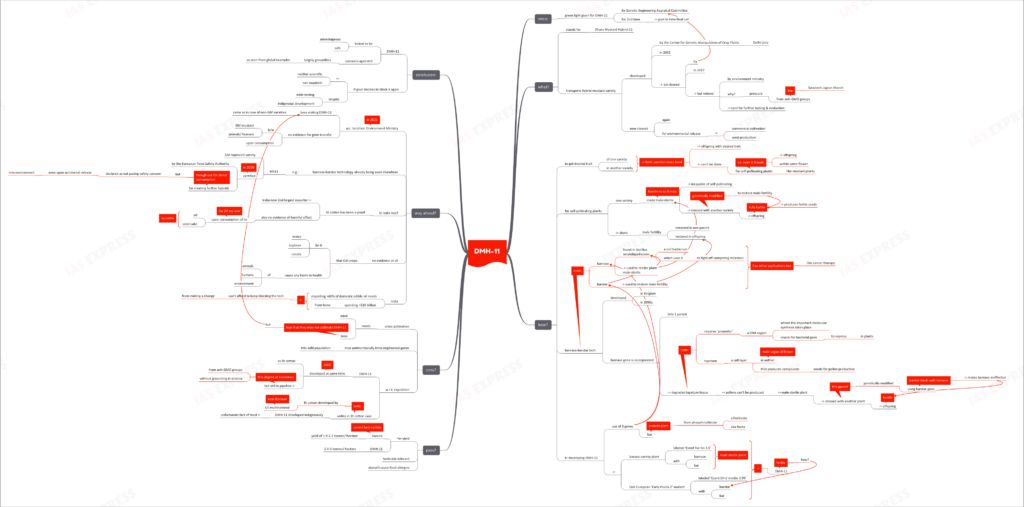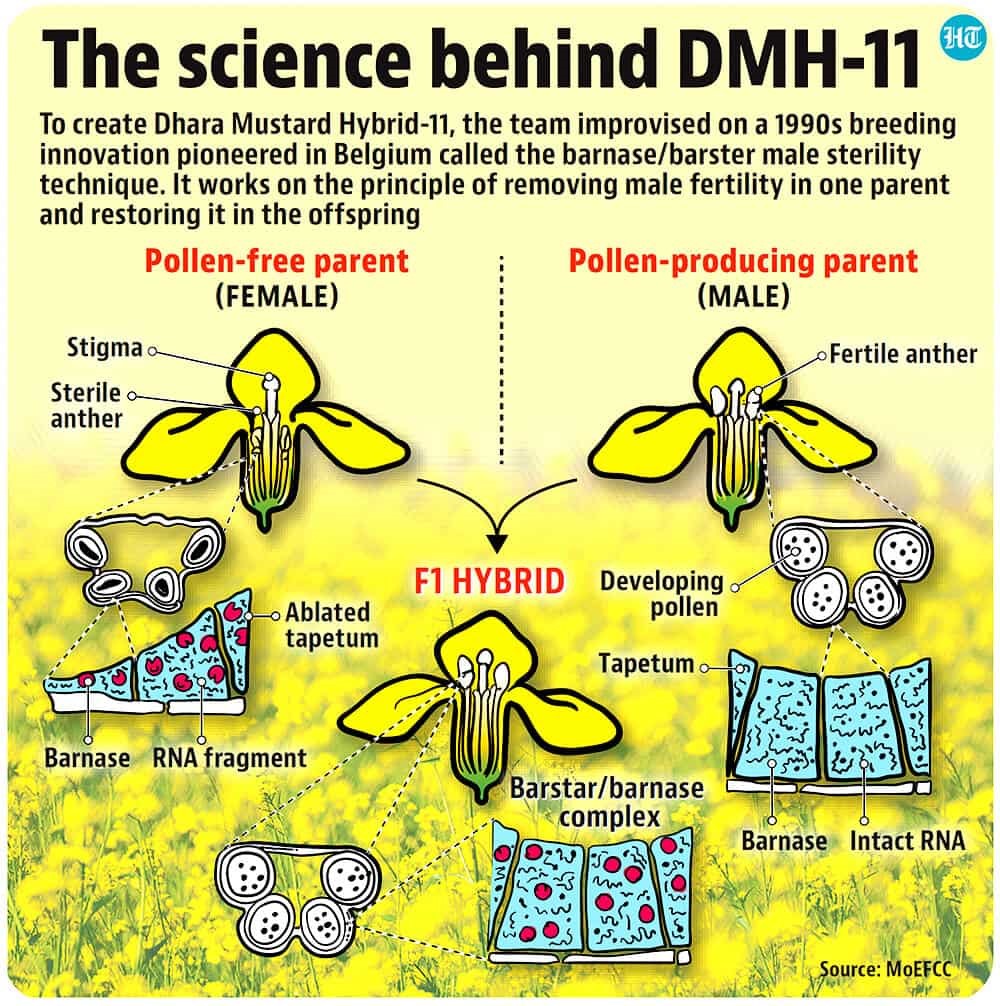DMH-11- Technology Used, Pros and Cons

The Genetic Engineering Appraisal Committee recently gave the green light for releasing the DMH-11, a GM crop. This is the second time that this GM mustard variety is getting the go ahead. The government is set to take a final call on releasing it for commercial cultivation.

What is DMH-11?
- DMH-11 or Dhara Mustard Hybrid-11 is a transgenic hybrid mustard variety developed by the Centre for Genetic Manipulation of Crop Plants, under Delhi University.
- The variety was first cleared by the GEAC in May 2017, but was vetoed by the Union Environment Ministry. The ministry, under pressure from anti-GMO groups like the Swadeshi Jagran Manch, directed the committee to evaluate further tests.
- Now, the GEAC has approved this GM crop for ‘environmental release’ for commercial cultivation and seed production.
How was it developed?
- To incorporate another crop variety’s desirable traits in a target crop variety, breeding these varieties together is usual approach. However, this method can’t be used for species, like mustard, which self-pollinating i.e. the seeds are produced using the male and female parts of the same plant.
- In such cases, one of the varieties is made male-sterile, thus making it incapable of self-pollinating. It is then crossed with the other variety, which is genetically modified to ensure that the resultant offspring isn’t sterile. In short, removing male fertility in a parent plant and restoring it in the offspring plant.
- The DMH-11 was developed by incorporating 3 genes:
- Barnase
- Found in Bacillus amyloliquefaciens, a soil bacterium
- The bacterium uses it to protect itself from its microbial competitors
- It was used to make the mustard variety male-sterile
- Barstar
- Used by the bacterium to protect itself from the effects of barnase
- It was used to restore male fertility in the offspring
- Along with barnase, it has other applications too, like cancer therapy
- Bar
- It is used to protect the plant from phosphinothricin, a herbicide that is commercially known as Basta
- Barnase
- This technology of employing barnase and barstar to switch male fertility on and off was developed in Belgium in the 1990s.
- The technology uses a ‘promoter’ to make sure that the genes work according to plan. Promoted is a portion of the DNA where the important molecular synthesis takes place. It is crucial in getting the bacterial genes to express their traits in plants.
- In this case, the barnase and barstar genes require, for their expression, a promoter specific to the tapetum, a cell layer that produces compounds necessary for pollen development in the flowers’ anthers (male organ)
- When the barnase gene is incorporates, the tapetum degrades and hence, the plant can’t produce mature pollens. The result is a plant that will function as the female.
- In the other flower, barstar gene is introduced. The barstar binds with barnase and renders it ineffective. As a result, the hybrid offspring, that the farmers would be cultivating, will be fertile and capable of producing seeds.
- In developing DMH-11, one of the parent plants, a Varuna variety plant labelled ‘Event Var bn 3.6’ incorporated the barnase and bar genes and functioned as the male-sterile plant. The other plant, labelled ‘Event EH-2 modbs 2.99’ or East European ‘Early Heera-2’ mutant had barstar and bar genes.
- The resulting offspring, the DMH-11, contains all three genes and is fully fertile.

What are the pros?
- The DMH-11 has a higher yield than the currently cultivated mustard varieties. While the current best variety ‘Varuna’ gives a yield of 1.9-2.2 tonnes per hectare, DMH-11 gives a yield of 2.4-3 tonnes/ hectare on average.
- It is herbicide tolerant.
- Studies have shown that it doesn’t cause food allergies.
What are the cons?
- Cross-pollination occurs with the help of wind or bees. There is a concern whether the new variety will be able to attract bees.
- There is a worry that GM plants might introduce engineered genes into wild populations with unintended consequences.
In terms of regulation:
- Like Bt cotton, DMH-11 too was developed in 2002. Unlike Bt cotton, it has take DMH-11 to progress to this stage. Even now, there is uncertainty over whether the GEAC green light would translate into final approval from the government.
- This shows the degree of resistance to the adoption of the GM technology. The main concern is that this resistance isn’t grounded in science.
- Unlike in case of Bt cotton that was developed by a US (now German) multinational firm, the DMH-11 was developed by a domestic publicly-funded university. The lack of trust is unfortunate.
What is the way ahead?
- The Union Environment Ministry, in 2021, clarified that studies on DMH-11 revealed that the number of bees visiting the GM variety was no different from the number visiting the non-GM varieties.
- It also pointed out the lack of evidence for gene transfer to humans/ animals upon consumption of GM mustard.
- The barnase-barstar technology used in developing the DMH-11 has been used elsewhere too. An example is the MS11 (a GM rapeseed variety) which was certified by the European Food Safety Authority for creating further hybrids (not for direct consumption) in 2020. Also note that authority declared that accidental environmental released of MS11 seeds doesn’t pose any safety concern.
- In India itself, Bt cotton has proven to be a success and India is now the 2nd largest exporter. No adverse effects have been reported even after 20 years of oil and seed cake, from Bt cotton, being fed to cattle.
- In fact, there is no evidence to demonstrate that GM crop, be it soybean, maize or canola, has any harmful effect on human, animal or environmental health.
- If the DMH-11 is approved, it would be the 1st GM food crop cultivated by the Indian farmers.
- As October-November constitutes the main mustard sowing season, the government has to take an early decision on releasing the GM mustard.
- At a time when India is importing over 60% of its edible oil needs and spending $19 billion from its forex for it in 2021-22, we cannot afford to keep blocking the technology from making a change.
Conclusion:
The DMH-11 has been tested to be advantageous and safe. The concerns of the many anti-GMO groups have been largely groundless, as seen from global examples. If the government again decides to block the release of this indigenously developed and widely tested variety, it would neither be scientific nor ‘swadeshi’.
Practice Question for Mains:
Discuss the technology used in developing the DMH-11. What are the challenges in adopting GM food crops in India? How can these impediments be overcome? (250 words)
If you like this post, please share your feedback in the comments section below so that we will upload more posts like this.

